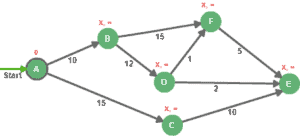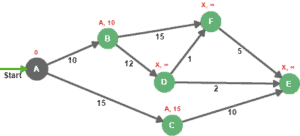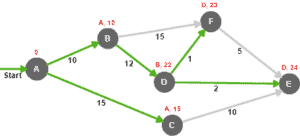1. 概述
本文重点讨论图论中的经典问题——最短路径问题(SPP),以及如何使用 Dijkstra算法 解决它。该算法的核心目标是:在带权图中,从指定起点出发,计算到所有其他节点的最短路径。
2. Dijkstra算法解决最短路径问题
给定一个正权图和起点(节点A),Dijkstra算法能确定起点到图中所有目标节点的最短路径和距离:

算法的核心思想是:持续淘汰起点到各目标节点的较长路径。为跟踪处理过程,需维护两个节点集合:
- 已确定节点集:已知从起点到该节点的最短距离
- 待处理节点集:可从起点到达但尚未确定最短距离的节点
以下是算法步骤:
- 起点距离设为0
- 其他节点距离设为无穷大(
Integer.MAX_VALUE) - 将起点加入待处理节点集
- 当待处理节点集非空时:
- 从待处理集中选择距离起点最近的节点作为当前评估节点
- 计算当前节点到其直接邻居的新距离,保留最小值
- 将未确定的邻居节点加入待处理集
这些步骤可分为初始化和评估两个阶段。下面结合示例图说明:
2.1 初始化阶段
开始探索前,需初始化所有节点:
- 起点(A)距离设为0
- 其他节点距离设为无穷大,前驱节点设为未知
初始化后的节点状态如下:

最后将起点A加入待处理节点集(此时已确定节点集为空)。
2.2 评估阶段
从待处理集中选择距离最小的节点(初始为A),评估其未确定的邻居:

核心操作:将当前节点距离与边权相加,与目标节点距离比较。例如:
- 节点B:0+10 < ∞ → 更新距离为10,前驱设为A
- 节点C:0+15 < ∞ → 更新距离为15,前驱设为A
然后将A移入已确定集,B、C加入待处理集。重复此过程直到所有节点被确定:

以下是完整的评估过程迭代表:
| 迭代 | 待处理集 | 已确定集 | 评估节点 | A | B | C | D | E | F |
|---|---|---|---|---|---|---|---|---|---|
| 1 | A | – | A | 0 | A-10 | A-15 | X-∞ | X-∞ | X-∞ |
| 2 | B, C | A | B | 0 | A-10 | A-15 | B-22 | X-∞ | B-25 |
| 3 | C, F, D | A, B | C | 0 | A-10 | A-15 | B-22 | C-25 | B-25 |
| 4 | D, E, F | A, B, C | D | 0 | A-10 | A-15 | B-22 | D-24 | D-23 |
| 5 | E, F | A, B, C, D | F | 0 | A-10 | A-15 | B-22 | D-24 | D-23 |
| 6 | E | A, B, C, D, F | E | 0 | A-10 | A-15 | B-22 | D-24 | D-23 |
| 最终 | – | ALL | NONE | 0 | A-10 | A-15 | B-22 | D-24 | D-23 |
符号说明:
B-22表示节点B是前驱节点,总距离为22
最终从起点A出发的最短路径:
- ✅ 节点B:A → B(距离10)
- ✅ 节点C:A → C(距离15)
- ✅ 节点D:A → B → D(距离22)
- ✅ 节点E:A → B → D → E(距离24)
- ✅ 节点F:A → B → D → F(距离23)
3. Java实现
3.1 图结构定义
用Graph类表示图,包含节点集合:
public class Graph {
private Set<Node> nodes = new HashSet<>();
public void addNode(Node node) {
nodes.add(node);
}
// getters and setters
}
Node类包含:
- 节点名称
- 最短路径(链表)
- 到起点的距离
- 邻接节点映射(存储邻居节点及边权)
public class Node {
private String name;
private List<Node> shortestPath = new LinkedList<>();
private Integer distance = Integer.MAX_VALUE;
private Map<Node, Integer> adjacentNodes = new HashMap<>();
public void addDestination(Node destination, int distance) {
adjacentNodes.put(destination, distance);
}
public Node(String name) {
this.name = name;
}
// getters and setters
}
⚠️
adjacentNodes使用邻接表实现,比邻接矩阵更适合Dijkstra算法
3.2 算法实现
核心算法实现:
public static Graph calculateShortestPathFromSource(Graph graph, Node source) {
source.setDistance(0);
Set<Node> settledNodes = new HashSet<>();
Set<Node> unsettledNodes = new HashSet<>();
unsettledNodes.add(source);
while (!unsettledNodes.isEmpty()) {
Node currentNode = getLowestDistanceNode(unsettledNodes);
unsettledNodes.remove(currentNode);
for (Map.Entry<Node, Integer> adjacencyPair :
currentNode.getAdjacentNodes().entrySet()) {
Node adjacentNode = adjacencyPair.getKey();
Integer edgeWeight = adjacencyPair.getValue();
if (!settledNodes.contains(adjacentNode)) {
calculateMinimumDistance(adjacentNode, edgeWeight, currentNode);
unsettledNodes.add(adjacentNode);
}
}
settledNodes.add(currentNode);
}
return graph;
}
辅助方法:
getLowestDistanceNode():从待处理集中选择距离最小的节点calculateMinimumDistance():更新最短距离和路径
private static void calculateMinimumDistance(Node evaluationNode,
Integer edgeWeight,
Node sourceNode) {
Integer sourceDistance = sourceNode.getDistance();
if (sourceDistance + edgeWeight < evaluationNode.getDistance()) {
evaluationNode.setDistance(sourceDistance + edgeWeight);
LinkedList<Node> shortestPath = new LinkedList<>(sourceNode.getShortestPath());
shortestPath.add(sourceNode);
evaluationNode.setShortestPath(shortestPath);
}
}
3.3 使用示例
构建示例图并计算最短路径:
Node nodeA = new Node("A");
Node nodeB = new Node("B");
Node nodeC = new Node("C");
Node nodeD = new Node("D");
Node nodeE = new Node("E");
Node nodeF = new Node("F");
nodeA.addDestination(nodeB, 10);
nodeA.addDestination(nodeC, 15);
nodeB.addDestination(nodeD, 12);
nodeB.addDestination(nodeF, 15);
nodeC.addDestination(nodeE, 10);
nodeD.addDestination(nodeE, 2);
nodeD.addDestination(nodeF, 1);
nodeF.addDestination(nodeE, 5);
Graph graph = new Graph();
graph.addNode(nodeA);
graph.addNode(nodeB);
graph.addNode(nodeC);
graph.addNode(nodeD);
graph.addNode(nodeE);
graph.addNode(nodeF);
graph = Dijkstra.calculateShortestPathFromSource(graph, nodeA);
执行后,每个节点的
shortestPath和distance属性将被更新,结果与第2节的理论计算完全一致
4. 总结
本文详细介绍了Dijkstra算法如何解决最短路径问题,并给出了完整的Java实现。核心要点:
- ✅ 适用于正权图的最短路径计算
- ✅ 通过维护两个节点集(已确定/待处理)逐步求解
- ✅ 时间复杂度为O(V²)(V为节点数),可用优先队列优化至O(E+V log V)
完整实现代码可在 GitHub项目 中获取。